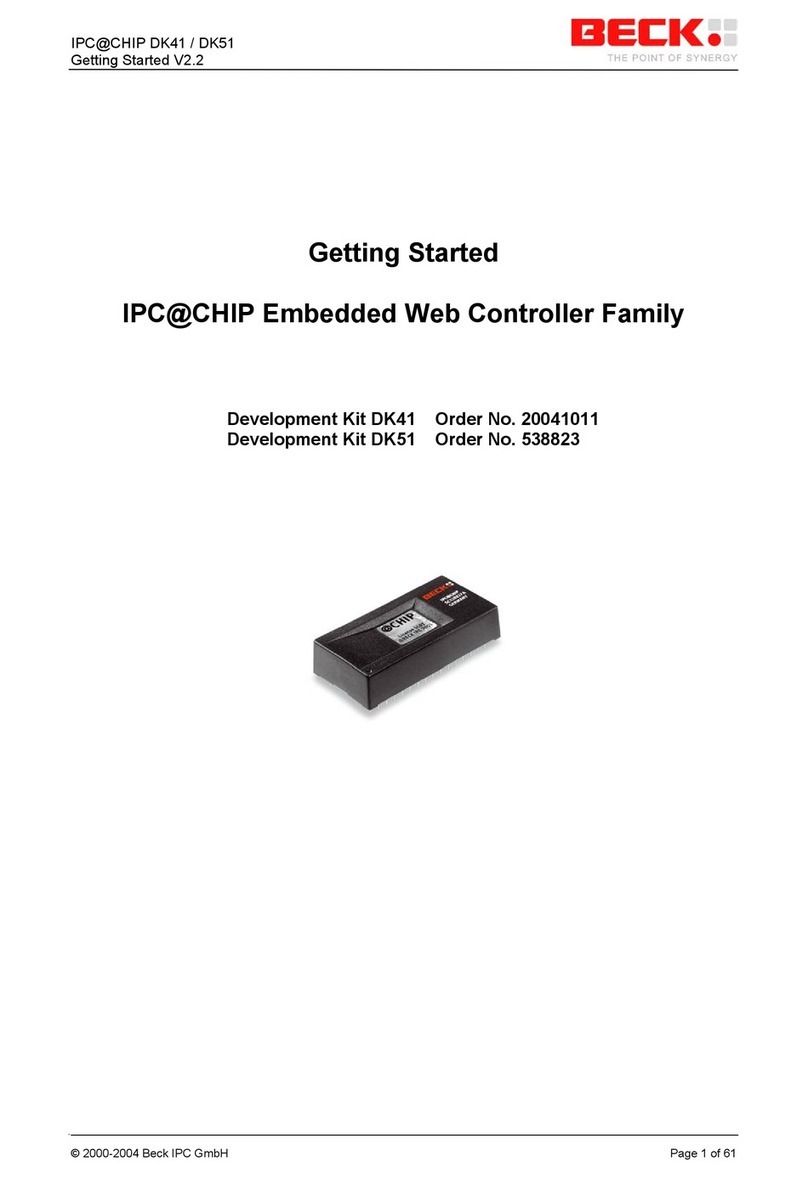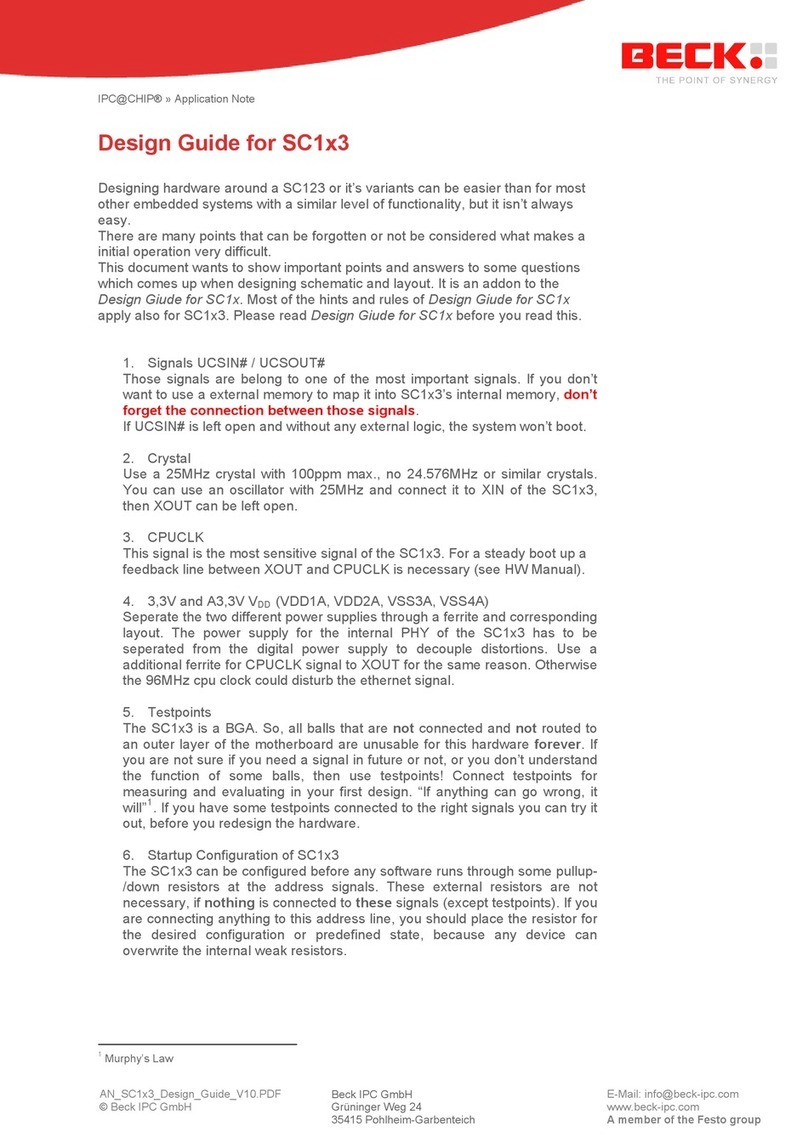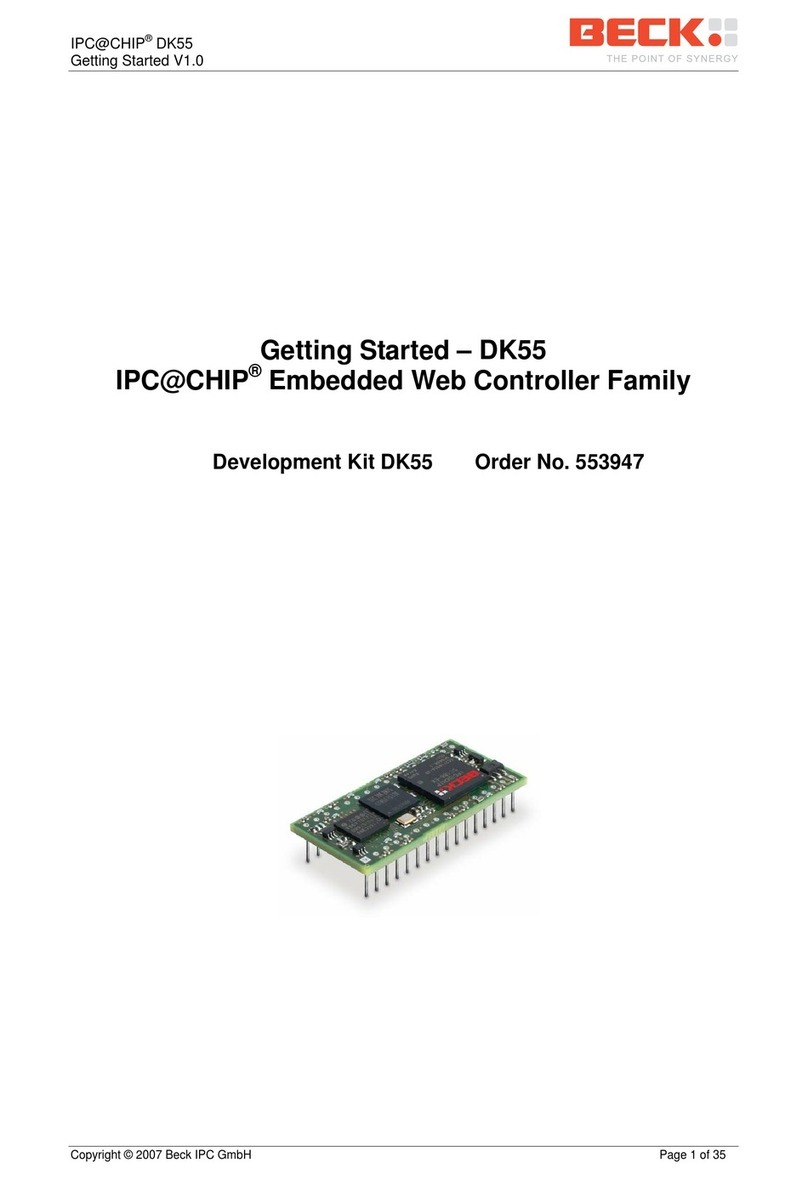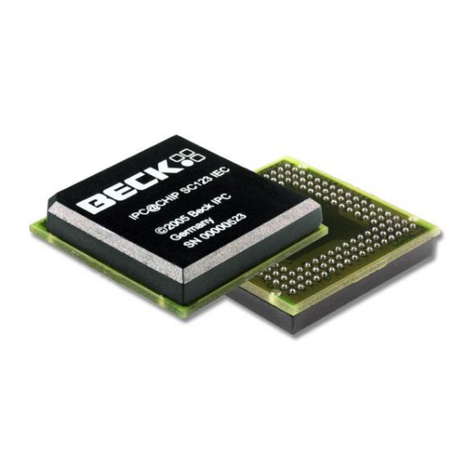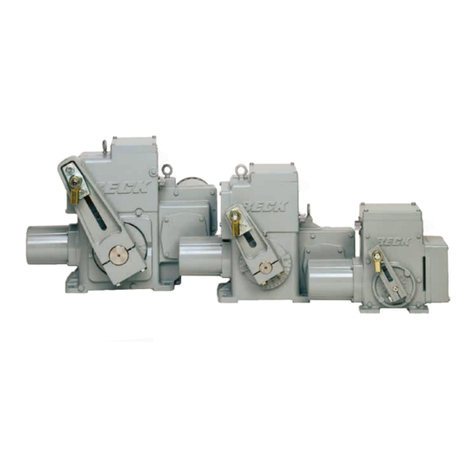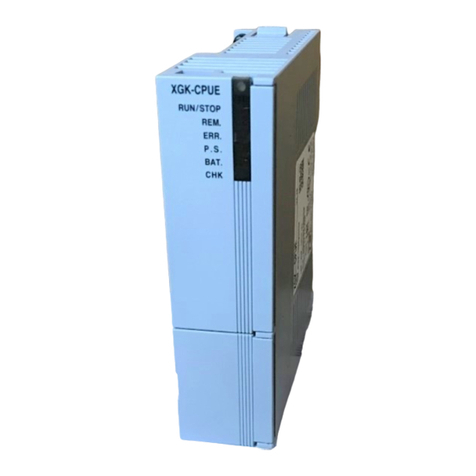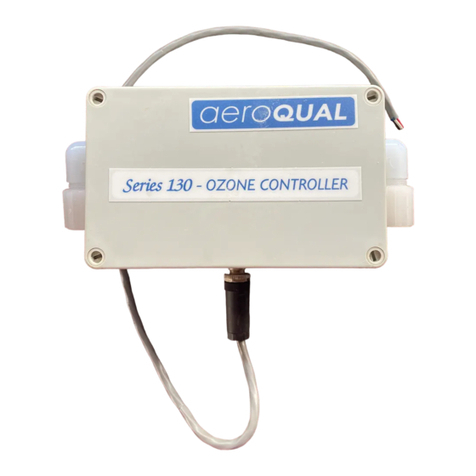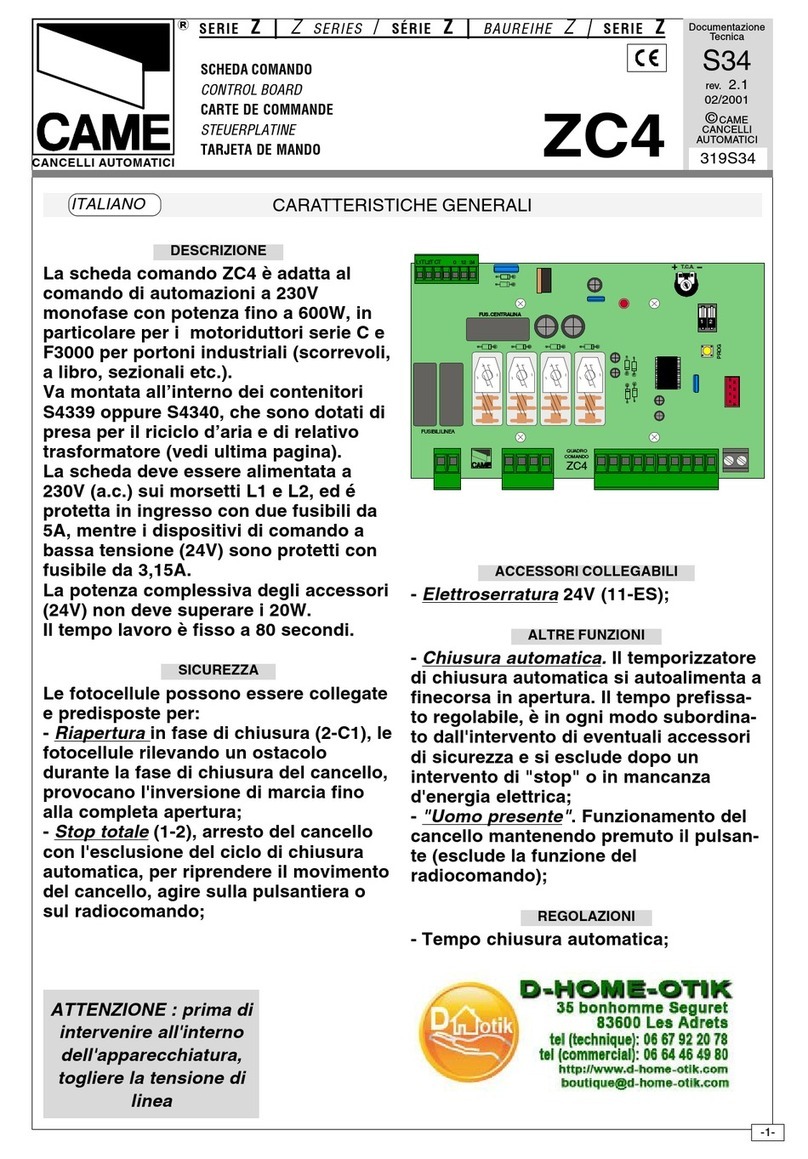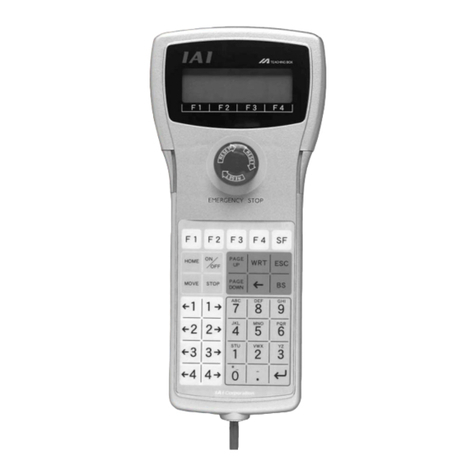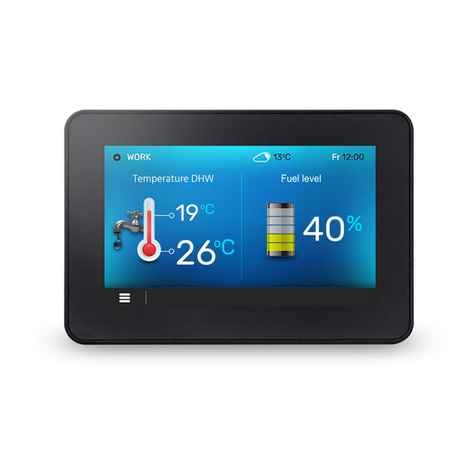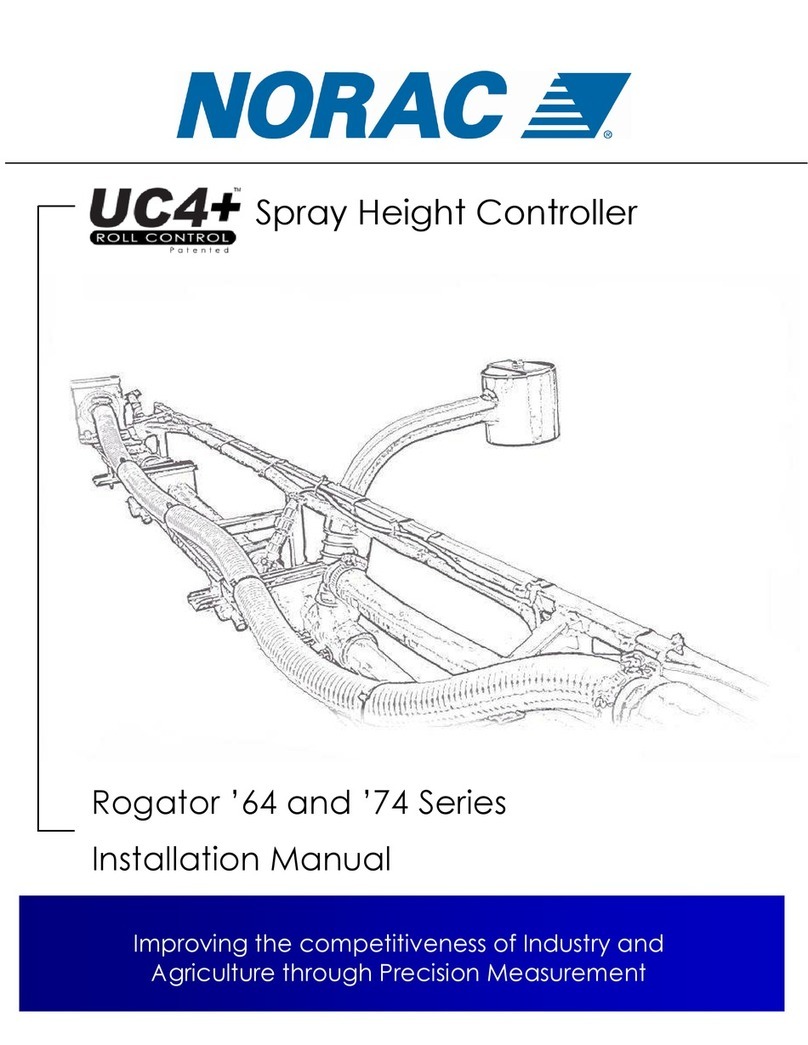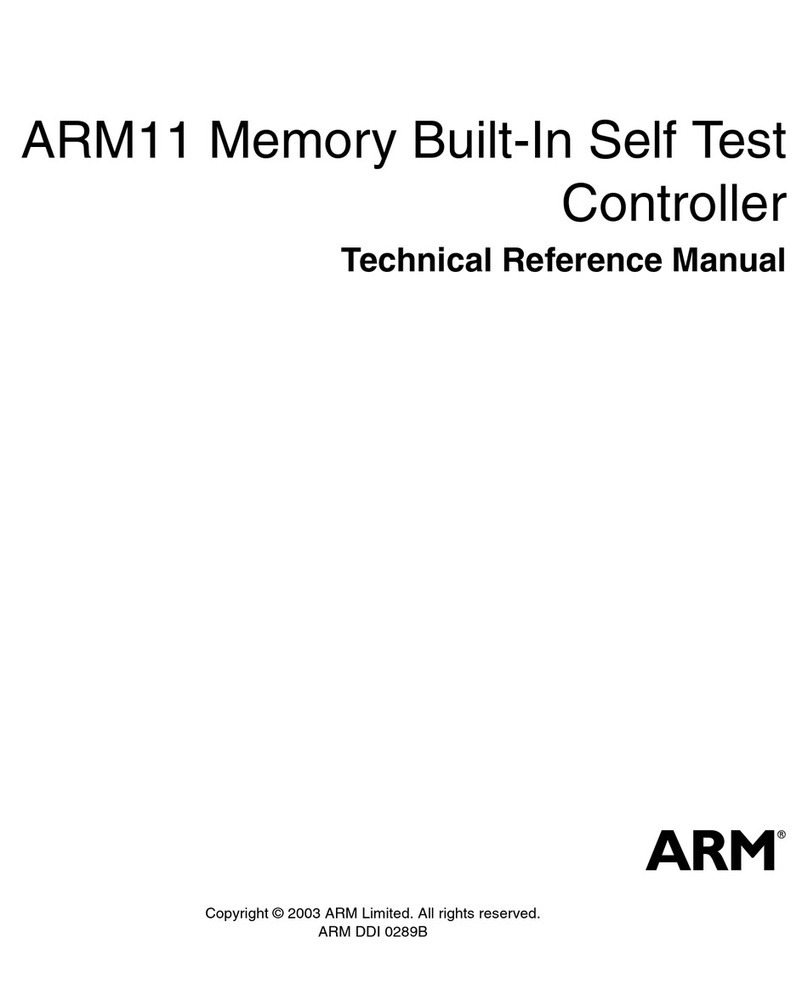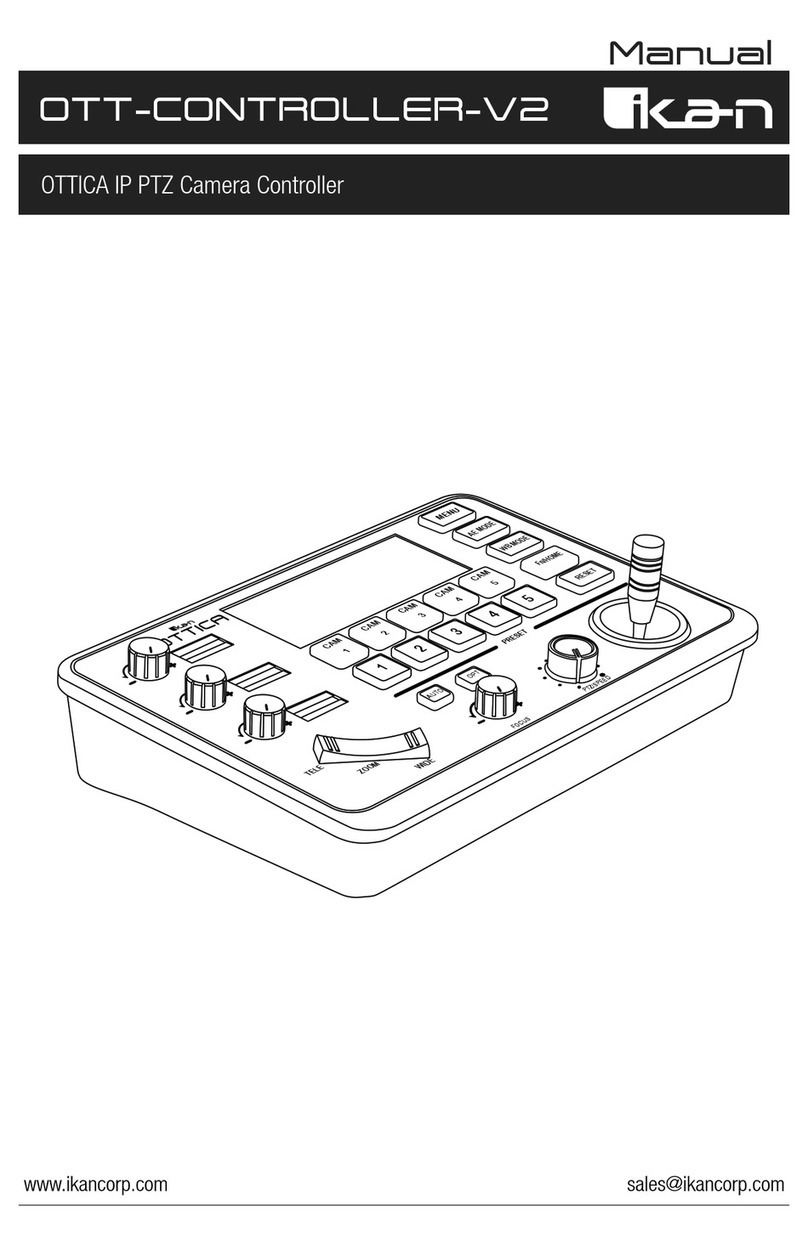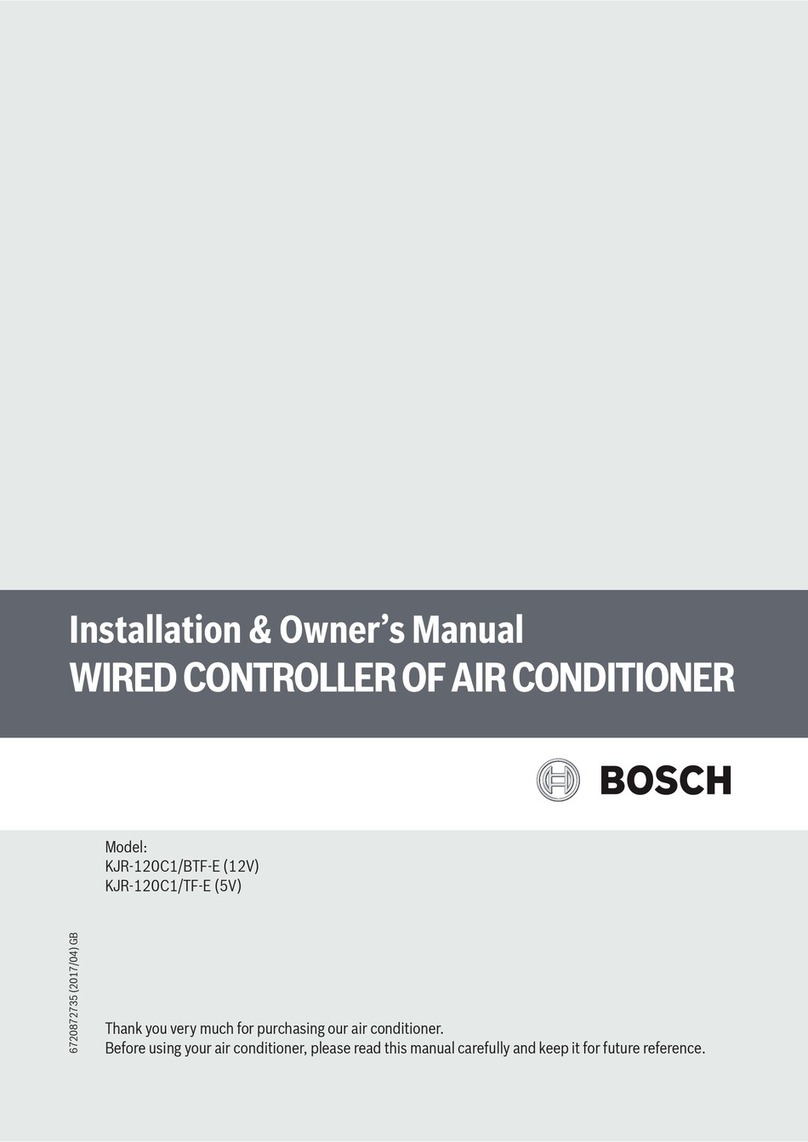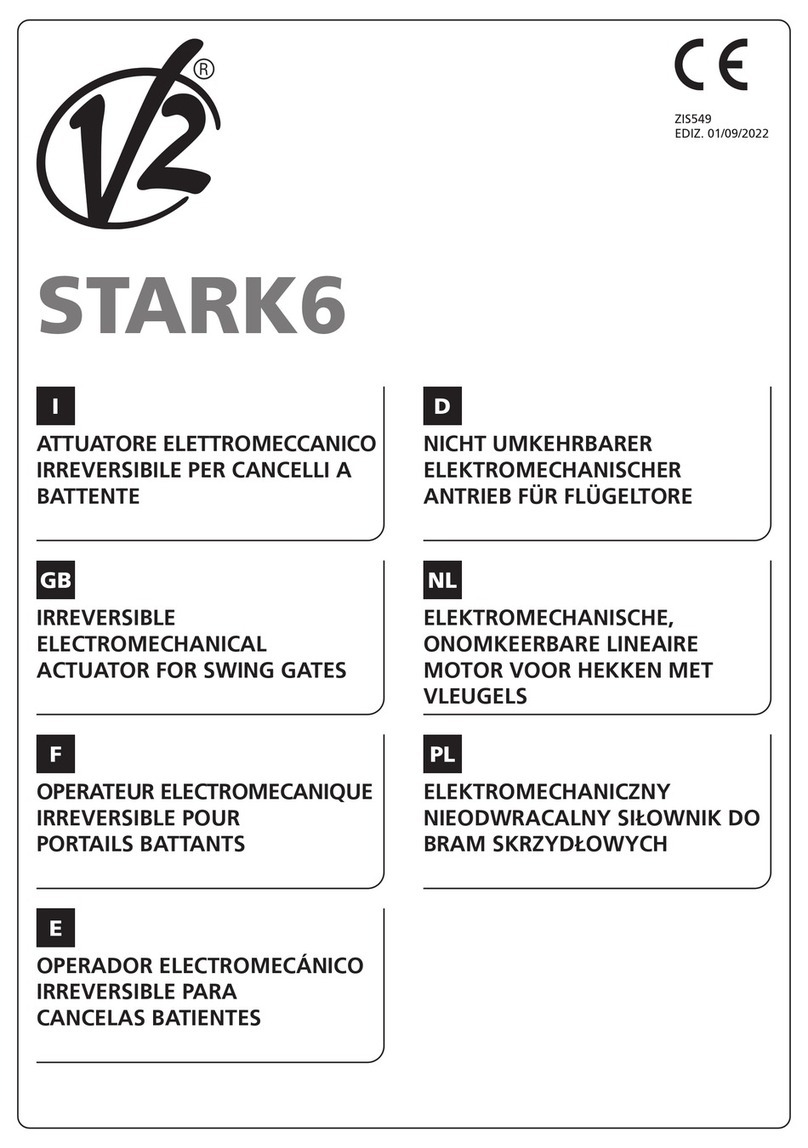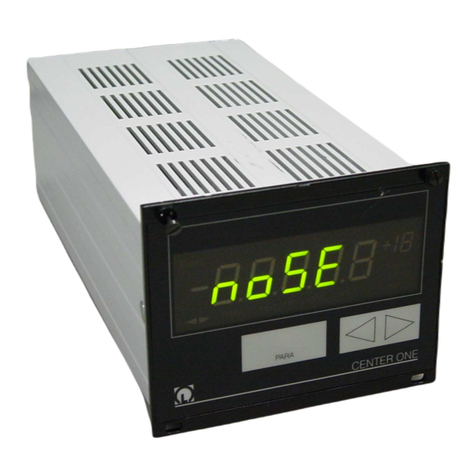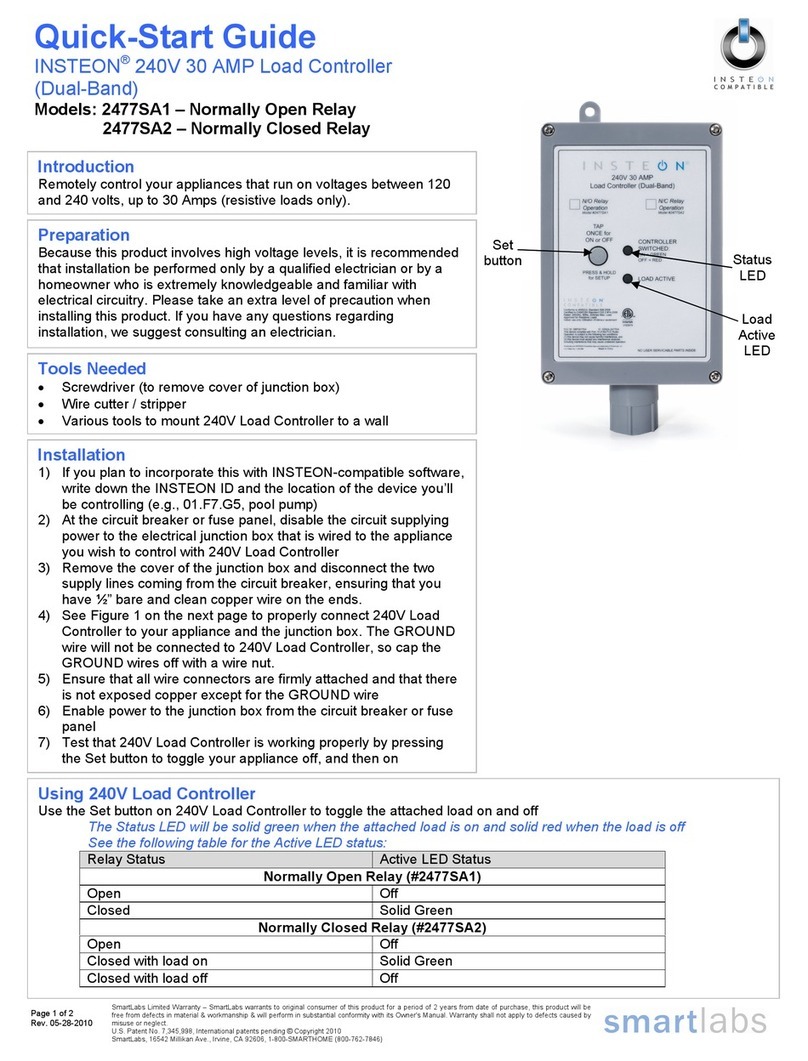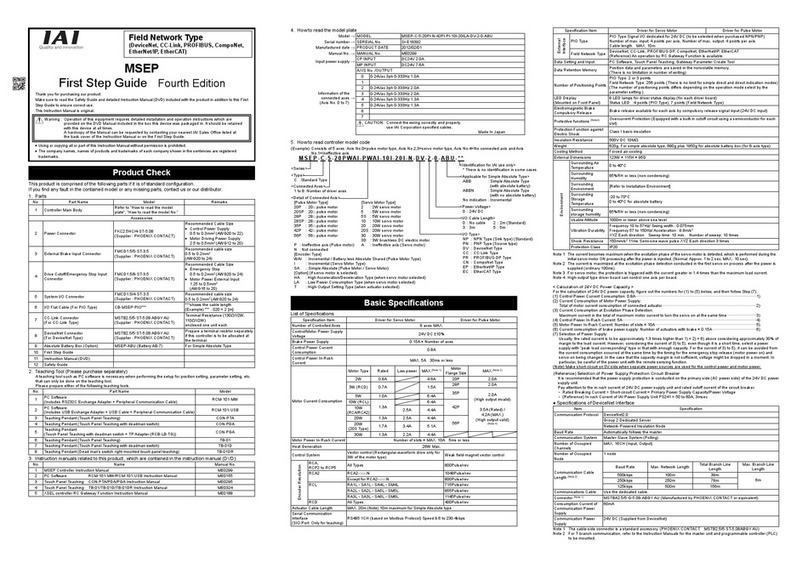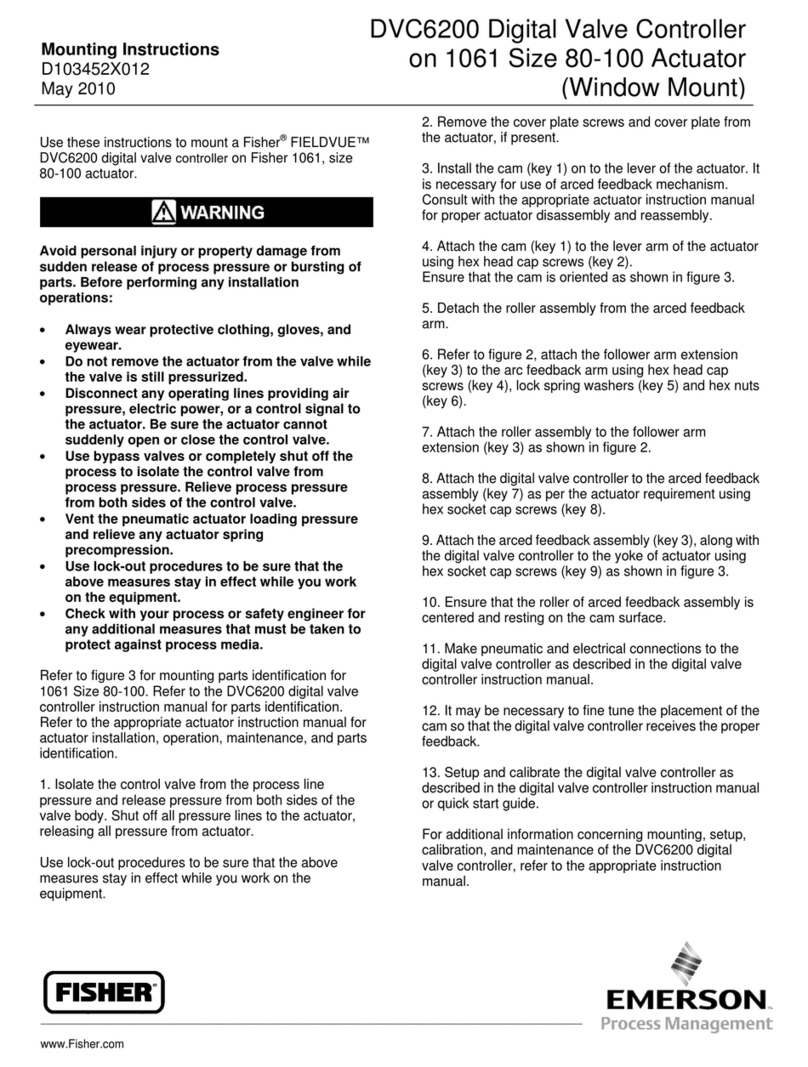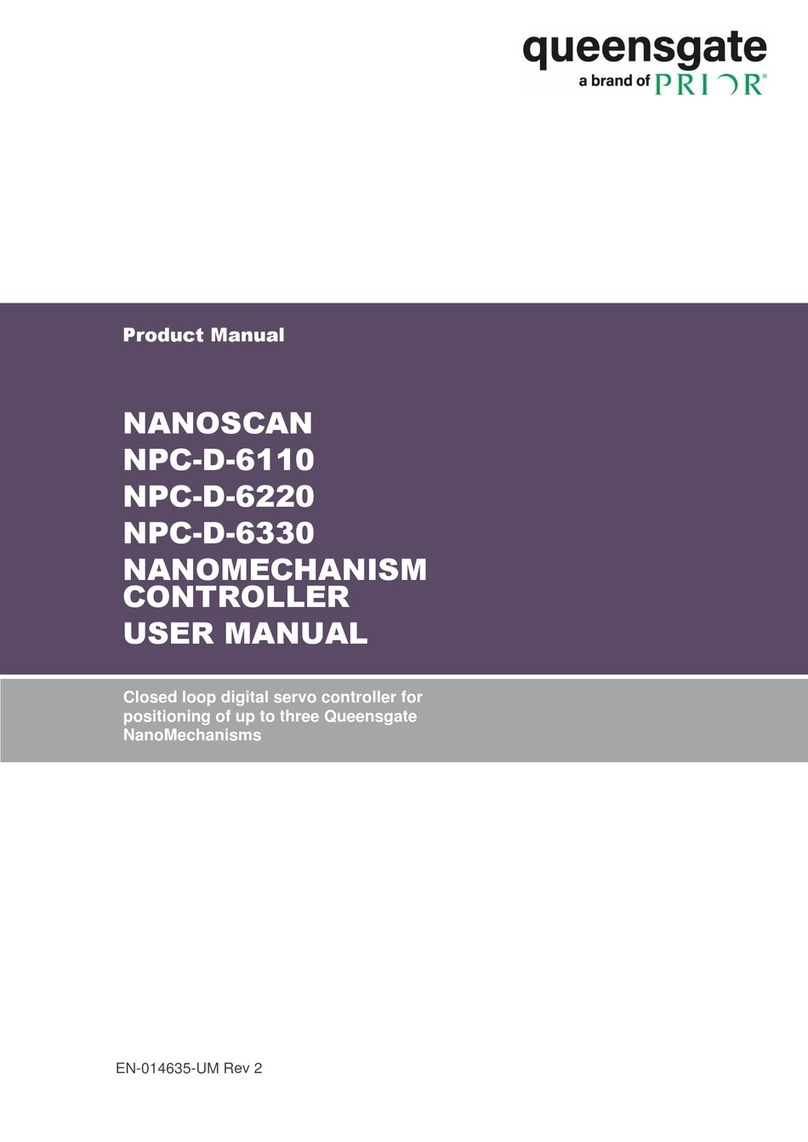Beck 22 Series User manual

ELECTRIC ACTUATORS FOR INDUSTRIAL PROCESS CONTROL
22-309
22-409
22-809
MODELS
Group 22 - Quick Reference
PAGES 2-7 -- WIRING CONNECTIONS
PAGES 8-11 -- ELECTRONICS
PAGES 12-13 - MAINTENANCE KITS
PAGES 14-17 -- TROUBLESHOOTING
AND TESTPOINTS
PAGES 18-19 -- HART MENU
This reference supports
Group 22 actuators
using DCM-2 part numbers:
12-8224-41
12-8224-45
12-8224-51
12-8224-55

Group 22
Quick Reference
INSTALLATION - ELECTRICAL
2
POWER QUALITY
Power quality disturbances such as power
outages, transient voltages, harmonic distortions,
and electrical noise should be accounted for
during installation of your drive. Protecting your
drive from these conditions can reduce downtime
and promote a longer lifetime for the equipment.
Following the recommendations below will
maximize the protection.
aSelect wiring materials according to the correct
ampacity ratings dictated by national and local
regulations.
aShielded, twisted pair cables can be used for
signal connections to avoid being affected by
electrical noise. These signal wires, based
on Noise Susceptibility Level (NSL) per
IEEE-518, fall into the level 1 classification.
A braided shield will be more effective than
a wrapped foil shield. Signal wire shields
should be connected to the drive casting
grounding screw. If grounding at the signal
source is required, then the shield should not
be grounded at the drive.
aRaceways such as conduits and trays have
to be grounded at both ends to properly meet
immunity requirements.
aAn AC power ground connection should be
made between the power source and the
Beck drive. Grounding connections including
wire and metal conduit are permitted, except
the drive-grounding conductor may not be
connected to a structured metal frame of a
building.
aSurge suppression equipment that meets
Underwriters Laboratory (UL) Standard 1449
may be used to protect against transient
voltage conditions.
aPower Conditioners may be used to regulate
the supply voltage and maintain a constant
voltage level. They are helpful in protection
against voltage sags and swells, as well as
some measure of electrical noise protection.
aHarmonic lters may be used to minimize the
effects of supply voltage waveform distor-
tions and are used in applications that incur
a large amount of high-frequency electronic
noise.
ELECTRICAL INSTALLATION
Three 1” N.P.T. conduit connections are
provided for power and signal wiring to the
drive. One conduit is provided for signal wiring
connections, and the other conduits are provided
for power and auxiliary switch connections. Use of
a sealant on the threaded conduit connections is
recommended to keep moisture out. Routing the
conduits from below the drives will help to prevent
water and other contaminants from entering the
drive.
Power and signal wires should be routed
to the drive separately. Shielded cables are
recommended, otherwise the wires should be
installed in conductive conduit and/or cable trays.
Large, clearly labeled terminal blocks are
enclosed in a gasketed compartment. Terminals
will accommodate up to 12 AWG (3.31 mm2)
wires.
Refer to the wiring diagram furnished with your
Beck drive (fastened to the inside of the terminal
block cover) for proper AC power and signal
connections. It is advisable to provide normal
short circuit protection on the AC power line.
For maximum safety, the Beck drive body
should be grounded. Separate ground terminals
are provided in the wiring compartment for power
and signal wiring. Wire size 12 AWG (3.31 mm2)
is recommended for this purpose.
TERMINAL CONNECTIONS
The Group 22 terminal block assemblies have
screw-down clamp terminals with separation
barriers and nylon paper electrical shields (shields
not shown on terminal connection diagrams). The
terminals can accept a variety of lug types or a
bare wire. The maximum wire size capacity is #12
AWG (3.31 mm2).
TERMINAL SCREW TORQUES
Regardless of wire termination type, each
terminal screw should be torqued to the proper
specification upon landing your wire.
All input power terminal screws (terminals 1
to 3) on the model 22-309 and 22-409 should be
tightened to 10 lb-in. The input power terminal
screws on the model 22-809 and the optional
transformer enclosure for 22-309 and 22-409
drives should be tightened to 20 lb-in. All signal
wiring terminal screws (terminals 4 to 21) on all
Group 22 models should be tightened to 9 lb-in.
Both the power and signal ground screws should
be tightened to 20 lb-in.

Group 22
Quick Reference
3
SUPPLY POWER
TERMINALS 1, 2, AND 3
Standard supply power for the model 22-309 is
single-phase 120 VAC (refer to the drive nameplate
for specific rating). Input power connects line to
terminal 1, neutral to terminal 2, and ground to
the enclosure power ground screw. Terminal 3 is
unused for 120 VAC operation.
Standard supply power for the model 22-409
is three-phase 208 VAC. Standard supply power
for the model 22-809 is three-phase 480 VAC.
Lines 1, 2, and 3 connect to terminals 1, 2, and 3
respectively on each of these drives. The ground
wire should be connected to the enclosure power
ground screw.
Alternate voltage options include single-phase
240 VAC for the model 22-309 and three-phase
208, 240, 380, 416, 480, & 575 VAC for all Group
22 models. The model 22-309 and 22-409 require
an optional transformer enclosure to accommodate
any non-standard voltage configuration.
Group 22 drives are equipped with a transient
protector assembly installed across each, or a
combination of terminals 1, 2, and 3 (dependent
upon your drive model and configuration). Note:
The transient protector assembly should not be
removed.
AUXILIARY LIMIT SWITCHES
TERMINALS 4 THROUGH 9
Group 22 drives include two single pole double
throw (SPDT) auxiliary limit switches rated for 1
Amp at 250 VAC. These switches may be useful
for discrete position indication. The limit switches
are actuated by adjustable cams on the control
shaft (located with the position sensing device).
Details on standard factory switch settings can be
found in the configuration section of this manual.
AUTO MODE INDICATION
TERMINALS 10 AND 11
A dry contact is available at terminals 10 and
11 to indicate when the handswitch is in the AUTO
position. The switch contact is Form A; when
the handswitch is not in the AUTO position, the
contact is open and when the handswitch is in the
AUTO position, the contact is closed. The contact
is rated for 1 Amp at 250 VAC.
CAUTION
Always close covers immediately after
installation or service to prevent moisture or
other foreign matter from entering the drive.
SYSTEM ALARM
TERMINALS 12 AND 13
Indication of the system alarm is available as
a dry contact at terminals 12 and 13. The factory
standard is a form B contact configuration (open on
alarm). It is configurable to a form A configuration
(closed on alarm). Reference the configuration
section of the manual for additional details on how
to change this functionality. The contact is rated
for a maximum of 80 milliamps at 120 VAC/VDC.
DEMAND SIGNAL
TERMINALS 14 AND 15
The DCM monitors an analog 4-20 milliamp
input signal at terminals 14 (–) and 15 (+), and
positions the output shaft position to match in
response. The standard response is to follow the
demand signal linearly.
FEEDBACK SIGNAL
TERMINALS 16 AND 17
When feedback sourcing is enabled, the DCM-2
transmits a 4-20 milliamp position feedback signal
on terminals 16 (–) and 17 (+) that is proportional
to the drive output shaft position.
CONTROL OVERRIDE INPUTS
TERMINALS 18 THROUGH 21
Analog signal operation may be overridden by
using discrete input signals on the control override
input terminals. CW (19), CCW (20), and STOP
(21) terminals require connection to a common
(COM) terminal (18) to perform the override as
shown in the table below.
Terminal
Connections
Output Shaft
Action
19 to 18 Clockwise Rotation
20 to 18 Counter-Clockwise Rotation
21 to 18 Stop in Current Position
The connection to terminal 18 is designed to
be made through relay contacts or through a solid
state switch capable of sinking at least 5 milliamps
DC. When the circuit is open, terminals 19, 20,
and 21 should measure +12 VDC with respect to
terminal 18.
CAUTION
Do not connect an external voltage source to
override terminals 18–21; an external voltage
source may damage the DCM circuitry.

80-4280-02
Rev. 05.3
INSTALLATION - WIRING
4
4
3
2
1
5
6
7
8
9
10
11
12
13
14
18
17
21
16
20
15
19
Auxiliary
Switch 2
Auxiliary
Switch 1
Power
Handswitch
Auto Indication
Power
Ground
Signal
Ground
System Alarm
Demand Signal
Feedback Signal
Control Override
Inputs
Surge
Suppressor
Assembly
(22-309)
3
2
1
Power
Ground
Transient
Protector
Assembly
(22-309)
Transient
Protector
Assembly
(22-409)
1
2
3
Power
OPTIONAL
TRANSFORMER
ENCLOSURE POWER
CONNECTIONS
FOR MODELS 22-309 / 22-409
MODEL 22-309 & 22-409
TERMINAL CONNECTIONS
OPTIONAL ENCLOSURE
(Refer to page 41 for replacement
fuse part numbers)

80-4280-02
Rev. 05.3
5
See terminal
connction
table below
PSA-1 YEL
PSA-2
PSA-3
PSA-4
PSA-5
PSA-6 WHT
GRN
BLU
VIO
GRY
BRN
RED
ORG
YEL
RED
BRN
ORG
YEL
GRN
BLU
PSL-1
J1-2
PSL-4
PSL-3
PSL-2
J1-1
J1-3
J1-4
J1-5
J1-6
BRN
YEL
GRN
WHT
GRY
BLK
BRN
RED
ORG
RED
ORG
J3-1
J3-4
J3-2
J3-3
J5-1
J5-4
J5-3
J5-2
J5-5
J5-6
J4-4
J4-5
J4-8
J4-9
J4-1
J4-10
PP-2
PP-1
PP-3
PP-5
DCM FUSES
F1,F2,F3†
(8A 250V)
CW
RED
ORG
YEL
GRN
AUTO CCW STOP
BRN
WHT
BLK
RED
BRN
AUTO
5 4 3 12 109 11
12
J3-6
J2-5
J2-6
J2-4
J2-3
J2-1
J2-2
J3-9
J3-8
J3-7
J3-5
PP-9
PP-10
J4-2
J4-3
J4-6
J4-7
BLU
VIO
PP-16
PP-15
ORG
RED
PM-1
PM-2
PM-4
PM-3
YEL
ORG
RED
BRN
PP-11
PP-14
PP-13
PP-12
S1
S2
CW
TRAVEL LIMITS
CCW CONTACTLESS
POSITION
SENSOR SWITCHES
AUXILIARY
CUSTOMER TERMINAL BLOCK
250VAC, 1 AMP
INPUT / FEEDBACK SIGNALS:
ISA TYPE 4, CLASS U, POWER ISOLATED
STOP
CONTROL
SIGNAL
DEMAND
OVERRIDE
INPUTS
CCW
CW
COM
EXTERNAL
HART
COMMUNICATION
TERMINALS
DIGITAL
CONTROL
MODULE
HANDSWITCH
TORQUE
SENSING
MOTOR
80mA MAX.
OPENS ON ALARM
SYSTEM ALARM
120 VAC/VDC
HANDSWITCH AUTO
INDICATION
250VAC, 1 AMP
FEEDBACK TO CUSTOMER
CONTROL DRIVE
OUTPUT SHAFT POSITION
(DCM-2)
MODEL 22-309 & 22-409 TYPICAL WIRING SCHEMATIC
(a wiring schematic specic to each drive is located under the wiring terminal cover)
USE FUSE KIT
P/N 12-8061-53
TERMINAL CONNECTION TABLE
*Other operating voltages are available with an optional transformer.
†Fuse F3 is only applicable to the model 22-409.
22-309 22-409
Operating Voltage Phases Single-Phase Three-Phase
Operating Voltage Refer to drive nameplate for
voltage rating (120 or 240 VAC)*
208 VAC*
Terminal 1 Line Line 1
Terminal 2 Neutral Line 2
Terminal 3 Unused Line 3

80-4280-02
Rev. 05.3
INSTALLATION - WIRING
6
21
2015 16 17 18 19
14
4 7 8 9 10 11 12 136
5
Demand Signal
Feedback Signal
Control Override Inputs
Signal Ground
Power Ground
Auxiliary Switch 1
Handswitch Auto Indication
Auxiliary Switch 2
System Alarm
Power
Switch Ground
Transient
Protector
Assembly
MODEL 22-809 TERMINAL CONNECTIONS

80-4280-02
Rev. 05.3
7
G
CW
RED
J3-6
BRN J3-1
RED
ORG
YEL
RED
BRN
J3-4
J3-2
J3-3
J5-1
ORG
YEL
GRN
BLU
J5-4
J5-3
J5-2
J5-5
J5-6
STOP
CCW
CW
COM
ORG
YEL
J2-5
BRN
YEL
GRN
WHT
GRY
BLK
J4-4
J4-5
J4-8
J4-9
J4-1
J4-10
PP-2
PP-1
J2-6
J2-4
J2-3
J2-1
J2-2
J3-9
J3-8
J3-7
GRN
AUTO CCW
J4-6
J4-7
BLU
VIO
PP-16
PP-15
J3-5
PP-9
PP-10
ORG
RED
STOP
BRN
WHT
BLK
RED
BRN
AUTO
PSL-1
J1-2
PSL-4
PSL-3
PSL-2
J1-1
J1-3
J1-4
J1-5
J1-6
PSA-1 YEL
PSA-2
PSA-3
PSA-4
PSA-5
PSA-6 WHT
GRN
BLU
VIO
GRY
5 4 3 12 109 1112
PP-3
PP-5
RED
ORG
J4-2
J4-3
PP-14
PP-13
YEL
ORG PM-3
PM-4
PP-11
PP-12 RED
BRN
PM-2
PM-1
PM-5GRN
PP-15
PM-6BLU
PP-16
BLK
BLK
BLK
GRN
HANDSWITCH
CONTROL
SIGNAL
DEMAND
OVERRIDE
INPUTS DIGITAL
CONTROL
MODULE
TORQUE
SENSING
80mA MAX.
OPENS ON ALARM
SYSTEM ALARM
120 VAC/VDC
HANDSWITCH AUTO
INDICATION
CW
TRAVEL LIMITS
CCW CONTACTLESS
POSITION
SENSOR
S1
S2
SWITCHES
AUXILIARY
CUSTOMER TERMINAL BLOCK
#
250VAC, 1 AMP
250VAC, 1 AMP
MOTOR
DCM FUSES
F1,F2,F3
(8A 250V)
FEEDBACK TO CUSTOMER
CONTROL DRIVE
OUTPUT SHAFT POSITION
EXTERNAL
HART
COMMUNICATION
TERMINALS
INPUT / FEEDBACK SIGNALS:
ISA TYPE 4, CLASS U, POWER ISOLATED
ORG
RED
BRN
LINE 2
LINE 3
LINE 1
G
3-PHASE POWER
REFER TO DRIVE
NAMEPLATE FOR
VOLTAGE RATING
(DCM-2)
MODEL 22-809 TYPICAL WIRING SCHEMATIC
(a wiring schematic specic to each drive is located under the wiring terminal cover)
* Kits also include (3) 8 Amp, 250 Volt DCM fuses.
Three-Phase
Voltage Rating Fuse Rating
Fuse Kit
Part Number*
208 10 Amps, 600 Volts 12-8061-51
240 10 Amps, 600 Volts 12-8061-51
380 4 Amps, 600 Volts 12-8061-52
416 4 Amps, 600 Volts 12-8061-52
480 4 Amps, 600 Volts 12-8061-52
575 4 Amps, 600 Volts 12-8061-52

Group 22
Quick Reference
ELECTRONICS
DIGITAL CONTROL MODULE (DCM-2)
8
DCM
COMPARTMENT
CONTROL END
COMPARTMENT
The DCM-2 is a micro-processor based circuit
board assembly that serves as the actuator’s
control center. The DCM-2 chassis assembly
is comprised of a Control circuit board, a Driver
circuit board (inverter circuit), additional circuit
components like capacitors and transformers,
and an aluminum chassis to which both the
boards and the components are fastened. The
whole assembly is mounted in the actuator’s DCM
compartment (see photo).
The main function of the DCM-2 chassis
assembly is to be the actuator’s positioner. The
control board compares the Demand input signal
to the actuator shaft position feedback signal from
the Contactless Position Sensor (CPS-4) located
in the control end compartment (see photo).
See the troubleshooting section of this manual
for details regarding the fuse locations, the test
point locations, and expected test point voltage
levels.
INTERFACES
The DCM-2 has three configuration interfaces:
a local pushbutton interface, a HART interface,
and a serial port interface.
PUSHBUTTONS
The local pushbutton interface is integral to
the DCM-2 assembly. It requires no additional
equipment to perform calibration procedures,
but is limited in functionality. This interface
also has LEDs for diagnostic information.
HART
The HART interface may be accessed by a
HART handheld communicator* or a HART
equipped control system. All electronic
calibration, configuration, and diagnostics
can be accomplished through HART
communications.
SERIAL PORT
The serial port interface is accessible by
connecting a computer to the DCM-2 using a
Beck serial cable**. All electronic calibration
and configuration can be accomplished
through the serial port interface.
The DCM-2 chassis assembly is mounted in a
dedicated compartment (see photo) and normally
does not need to be removed.
Accessing the DCM-2 assembly may be
required for configuration or diagnostic purposes
using either the pushbutton or serial port
interfaces.
If the DCM-2 needs to be repaired for any
reason, the whole chassis should be removed and
replaced as an assembly. See the Maintenance
section of this manual for complete details on
chassis removal and installation.
* See the HART appendix for details on connecting via HART
communicators.
** See the serial port appendix for details on connecting via
the serial port.

Group 22
Quick Reference
9
R
1
10
1
1
11
FWD
STAT
REV
PWR
TP4
SERIAL
PORT
TP1
INPUT
RESISTOR
R11
TP3
TP2
MOUNTING
SCREWS
SERIAL PORT
DCM
FUSES
LOCAL
PUSHBUTTON
INTERFACE
STATUS INDICATION
LEDs
OVERVIEW
LEDs
MOUNTING
SCREWS
CALIBRATE
SET POS
100%
SET POS
0%
SET DEM
100%
SET DEM
0%
DEMAND
POSITION
TORQUE
STALL
TEMP °F
FB OPEN
UVOLT
ACKNOWLEDGE
J5 J2
J4 J3A J3B
F1
F2
J5
TB1 TB2 TB3 TB4 TB5
TB6
12-8224-41
MODEL 22-309 DIGITAL CONTROL MODULE (P/N 12-8224-41)
FUSES
8 AMP
12-8224-51
1
SERIAL
PORT
J4 J3A J3B
TP4
TP1
J5
FWD
STAT
REV
PWR
CALIBRATE
SET POS
100%
SET POS
0%
SET DEM
100%
SET DEM
0%
DEMAND
POSITION
TORQUE
STALL
TEMP °F
FB OPEN
UVOLT
ACKNOWLEDGE
F1
F2
F3
INPUT
RESISTOR
R11
TP3
TP2
DCM
FUSES
LOCAL
PUSHBUTTON
INTERFACE
MOUNTING
SCREWS
MOUNTING
SCREWS
STATUS INDICATION
LEDs
OVERVIEW
LEDs
SERIAL PORT
MODEL 22-409 & 22-809 DIGITAL CONTROL MODULE (P/N 12-8224-51)

Group 22
Quick Reference
ELECTRONICS
10
FWD
STAT
REV
PWR
CALIBRATE
SET POS
100%
SET POS
0%
SET DEM
100%
SET DEM
0%
DEMAND
POSITION
TORQUE
STALL
TEMP °F
FB OPEN
UVOLT
ACKNOWLEDGE
LOCAL PUSHBUTTON
INTERFACE / LEDs
OVERVIEW LEDs
There are four LEDs in the upper right corner
of the DCM-2 circuit board. These provide an
overview of DCM-2 status.
PWR
This LED is lit when power is applied to the
drive. After initial power up, this LED pulses
from bright to dim indicating the micro-
processor is operating.
STAT
This LED is lit when a system alarm occurs.
When the STAT LED is lit, typically a status
indication LED will be illuminate to further
explain the status.
REV
This LED is lit when the drive is instructed to
move in the reverse direction. The instructions
may come from a demand signal, a control
override input, the handswitch, HART, or serial
commands.
FWD
This LED is lit when the drive is instructed to
move in the forward direction. The instructions
may come from a demand signal, a control
override input, the handswitch, HART, or serial
commands.
STATUS INDICATION LEDs
The status indication LEDs are located on the
left side of the local pushbutton interface.
The applicable status indication LED(s) will
illuminate when the “STAT” LED is lit, to reveal
the condition(s) as described below. When more
than one status LED is required at one time, the
illuminated LEDs will cycle rather than illuminate
all at once.
Refer to the troubleshooting section of this
manual for corrective actions that will eliminate
system alarms, status indication LEDs from being
lit, and the STAT LED from being lit.
DEMAND
The demand signal is outside of the acceptable
range of values.
(Standard current range is 3.2 - 21.0 mA DC)
POSITION
The internal position signal from the CPS-4
is outside of the acceptable range of values.
(Standard voltage is 1.3 - 3.7 volts DC)
TORQUE
The torque sensed at the output shaft of the
actuator exceeds the torque alarm threshold.
(Standard torque alarm threshold is 105%)
STALL
The drive is in a stall condition and stall
protection has been activated.
TEMP °F.
The temperature sensed at the DCM-2 is
outside of the acceptable range.
(Acceptable range is -40°F to 185°F (-40°C
to 85°C)
FB OPEN
The feedback current loop is disconnected,
open, or does not sense a load.
UVOLT
The operating voltage is below the rated
voltage tolerance (under voltage condition).
This LED could also be lit if an individual phase
of a three-phase operating voltage is lost.
ACKNOWLEDGE
Temporarily lit when a pushbutton configuration
operation is performed to confirm that the
pushbutton configuration operation has been
completed.
When a status LED is lit the system alarm
contact will change state. Indication of the system
alarm is available as a dry contact at terminals 12
and 13. The standard factory setting is for the
contact to be closed in the normal state and open
in an alarm state.

Group 22
Quick Reference
11
COUPLING
THUMB NUT
SWITCH CAMS
COUNTER-CLOCKWISE SWITCH
CLOCKWISE SWITCH
PIN CONNECTORS
AUXILIARY
SWITCH S2
AUXILIARY
SWITCH S1
THUMB NUT
LOCKING SCREW
(Do Not Adjust Set Screws (4))
CONTACTLESS POSITION SENSOR
(CPS-4)
CONTROL END / CONTACTLESS POSITION SENSOR
CONTROL END
The control end assembly is comprised of
the contactless position sensor (CPS-4), limit
switches, and limit switch cams. The control end
assembly is located in the actuator’s control end
compartment under the cylinder shaped cover.
The assembly is installed on the control shaft
which is geared into the main output shaft of
the actuator. As the output shaft turns it moves
the control shaft , the limit switch cams, and the
contactless position sensor ferrite core.
The control end includes two SPDT auxiliary
limit switches (labeled S1 and S2) for customer
connection and two over-travel limit switches
(labeled CW and CCW). The cams can be adjusted
to actuate the auxiliary switches anywhere in the
actuator’s range of travel.
CONTACTLESS POSITION SENSOR
(CPS-4)
The contactless position sensor (CPS-4) is a
circuit board and sensor assembly that is part of
the control end assembly. The CPS-4 provides
the DCM-2 with a continuous position signal
proportional to the position of the actuator’s output
shaft. The CPS-4 is located in the actuator’s
control end compartment under the cylinder
shaped cover.
The position sensing function of the CPS-4 is
provided by a ferrite magnetic sensing element.
An electronic circuit translates the voltage from
the ferrite magnetic sensor into a position signal.
The position signal is used by the DCM-2 to
determine the actuator’s output shaft position for
control and to generate an analog 4-20 milliamp
position feedback signal for external use.
LOCAL PUSHBUTTON INTERFACE
The five pushbuttons located on the local
pushbutton interface are used for simple calibration
features. To utilize the pushbuttons, the user must
press and hold the calibrate button, then press and
hold the button for the desired function. Pressure
should be maintained until the “ACKNOWLEDGE”
LED lights; this confirms receipt of the pushbutton
command.
See the calibration section of this manual for
further explanation of the calibration procedures.
CAUTION
Pressing the following buttons may
change calibration and cause the drive to
reposition.
CALIBRATE
As a safety feature, this button must be
pressed and held simultaneously with another
pushbutton to perform a calibration.
SET POS 100%
Calibrates the DCM-2 to recognize the current
output shaft position as the 100% position.
SET POS 0%
Calibrates the DCM-2 to recognize the current
output shaft position as the 0% position.
SET DEM 100%
Calibrates the DCM-2 to recognize the
currently applied demand signal as the 100%
demand signal.
SET DEM 0%
Calibrates the DCM-2 to recognize the
currently applied demand signal as the 0%
demand signal.

Group 22
Quick Reference
MAINTENANCE
12
COMPONENT REPLACEMENT
The Group 22 was designed modularly for
ease of maintenance and parts replacement. The
individual components of the actuator are available
in replacement parts kits as detailed in the
replacement parts kits tables in this section. Each
replacement parts kit includes the component(s),
necessary hardware, and detailed instructions for
installation of the parts.
HOW TO ORDER SPARE PARTS
Any customer replacement kit may be
purchased for spare parts, however several kits
have been selected by the factory as recommended
spares. Contact your Beck Sales Engineer for
questions regarding recommended replacement
parts particular to your application. Parts may be
ordered by mail, telephone, fax or e-mail, with the
confirming order sent to the factory.
ROUTINE MAINTENANCE
Beck drives require only a minimum of routine
maintenance. At regular plant maintenance
intervals, a visual inspection is recommended to
verify that the connection to the final control element
is intact and operating normally. If vibration is
present, check the electrical terminal connections
and other hardware for tightness. Check the
conduit seals for any moisture penetration and
reseal if necessary.
LUBRICATION
The Group 22 control drive has a grease
filled gear housing, so periodic lubrication is not
required. However, to extend the life of the linkage,
rod ends should be lubricated periodically.
GASKETS
During routine service, inspect the cover
gaskets for wear or damage. In order to protect
internal components, worn or damaged gaskets
and O-rings should be replaced.
To remove, scrape all of the old adhesive and
gasket material from the body housing and cover.
Cement the new gasket to the drive body using
a gasket cement such as 3M #847 Rubber and
Gasket Adhesive, or equivalent.
MOTOR
The motor assembly is not field-repairable and
is intended to last for the lifetime of the actuator.
Disassembly of the motor will result in a loss of
torque that can only be restored by returning the
motor to the factory for re-magnetizing.
If you suspect a motor problem, contact the
factory for assistance.
CAUTION
Before removing the control motor, block
the control drive crank arm to prevent the
crank arm and the gear train from moving
when the motor is removed. Failure to do
so can cause damage to equipment and
serious injury or death.
RECOMMENDED REPLACEMENT PARTS KITS
Applicable Model
Replacement Kit 22-309 22-409 22-809 KIT P/N
Control End Assembly X X X 12-8061-05
DCM Replacement (1-phase) X 12-8061-75
(DCM-2 p/n 12-8224-41)
DCM Replacement (1-phase) CE rating X 12-8061-78
(DCM-2 p/n 12-8224-45)
DCM Replacement (3-phase) X X 12-8061-85
(DCM-2 p/n 12-8224-51)
DCM Replacement (3-phase) CE rating X X 12-8061-88
(DCM-2 p/n 12-8224-55)
Gasket Set X X 12-8061-09
Gasket Set X 12-8061-29
Fuse Kit - 8 Amps
22-309 (120 VAC 1-phase ) & 22-409 (208 VAC 3-phase) X X 12-8061-53
*Fuse Kit - 8 Amps DCM & 4 Amps - input
380, 416, 480, 575 VAC ( 3-phase ) X12-8061-52
*Fuse Kit - 8 Amps DCM & 10 Amps - input
208, 240 VAC ( 3-phase ) X12-8061-51
* Select the proper Fuse Kit based on your actuator operating voltage.

Group 22
Quick Reference
13
3
2
1
Power
Ground
Transient
Protector
Assembly
(22-409)
3
2
1
Power
Ground
Transient
Protector
Assembly
(22-309)
Transient
Protector
Assembly
(22-809)
Power
Ground
GROUP 22 TRANSIENT PROTECTION
OTHER AVAILABLE REPLACEMENT PARTS KITS
Applicable Model
Replacement Kit 22-309 22-409 22-809 KIT P/N
CPS-4 Switch Assembly X X X 12-8061-06
CPS-4 P.C. Board X X X 12-8061-07
CPS-4 Coupling X X X 12-8061-08
Mounting Shim Set X X X 12-8061-11
Handswitch Assembly X X X 12-8061-12
Capacitor X 12-8061-14
Motor X X 12-8061-01
Handwheel / Dampener X X 12-8061-02
Self Locking Mechanism Rebuild X X 12-8061-69
Motor w/ Hand crank Assembly Replacement X 12-8061-20
Handwheel / Dampener X 12-8061-22
Self Locking Mechanism Rebuild X 12-8061-23
Hand crank Assembly X 12-8061-27
Service Screw Set X X 12-8061-10
Service Screw Set X 12-8061-30
*Fuse Kit - 8 Amps-DCM, & 4 Amps - input
240 VAC ( 1-phase ) X 12-8061-50
Optional Transformer fuse (9 A - 208 VAC) (3 required) X X 11-1372-10
Optional Transformer fuse (8 A - 240 VAC) (3 required) X X 11-1372-09
Optional Transformer fuse (4 A - 380 VAC) (3 required) X X 11-1372-06
Optional Transformer fuse (4 A - 416 VAC) (3 required) X X 11-1372-06
Optional Transformer fuse (4 A - 480 VAC) (3 required) X X 11-1372-06
Optional Transformer fuse (3.5 A - 575 VAC) (3 required) X X 11-1372-08
**Transient Protector (120 VAC, 1-phase) X 12-8061-44
**Transient Protector (240 VAC, 1-phase) X 12-8061-42
**Transient Protector (208 VAC, 3-phase) X 12-8061-43
**Transient Protector (208 VAC, 3-phase) X 12-8061-45
**Transient Protector (240 VAC, 3-phase) X 12-8061-46
**Transient Protector (380 VAC, 3-phase) X 12-8061-54
**Transient Protector (416 VAC, 3-phase) X 12-8061-55
**Transient Protector (480 VAC, 3-phase) X 12-8061-47
**Transient Protector (575 VAC, 3-phase) X 12-8061-48
** Select the proper Transient Protector Kit based on your actuator operating voltage.

Group 22
Quick Reference
TROUBLESHOOTING
14
CPS-4 TESTPOINTS
R
10
1
1
FWD
STAT
REV
PWR
SERIAL
PORT
TP1
CALIBRATE
SET POS
100%
SET POS
0%
SET DEM
100%
SET DEM
0%
DEMAND
POSITION
TORQUE
STALL
TEMP °F
FB OPEN
UVOLT
ACKNOWLEDGE
J3 J3A J3B
J5
INPUT
RESISTOR
R11
TP3
TP2
TP4
STATUS
INDICATION
LEDs
OVERVIEW
LEDs
DCM-2 TESTPOINTS
WHERE DO I START?
The Group 22 actuator was designed so the
user can quickly diagnose any actuator status
conditions causing an interruption in operation.
By removing the DCM compartment cover to
access the DCM-2, you can view the overview
and status indication LEDs. These LEDs provide
an efficient means of determining the actuator
problem, in many cases without the need for
metering equipment.
The following matrix lists some of the potential
conditions that a user may experience when
troubleshooting.
DCM-2
The DCM-2 board is the control center of the
drive. Drive configuration and calibration are
accessed and set through the DCM-2 board. The
DCM-2 has the overview and status indication
LEDs that indicate status and alarm conditions.
More advanced troubleshooting features may
be accessed via HART or serial connection (see
respective appendixes in this manual). Reference
Menu 8, Diagnostics menu, for troubleshooting
with HART and for serial port troubleshooting use
the diagnostic commands featured in the serial
port appendix.
The DCM-2 performs an error based positioning
function. It accepts a demand signal, compares it
to an internal position feedback voltage provided
by the CPS-4, and controls the motor to correct for
a difference. The DCM-2 includes four test points
for measuring the demand and internal position
signal voltages at the DCM-2. The demand
signal should measure 1-5 volts DC across test
points TP3 (-) and TP2 (+), proportional to the
4-20 mA demand input signal. The raw position
signal should measure approximately 1.3 to 3.7
volts DC across test points TP4 (+) and TP1 (-),
proportional to the output shaft’s 0-100 degree
position (shaft position can be determined by
viewing the mechanical index).
CPS-4
The output voltage of the CPS-4 ranges from
1.3 to 3.7 volts DC for 100° drive shaft rotation.
This can be measured across CPS-4 test points
TP3(+) and TP1(-). If the position signal is outside
the anticipated range, the “STAT” and “POSITION”
LEDs will light, and contacts at terminals 12 &
13 will open if the PositionLOS alarm mask bit
is ON (default state). When the Position signal
is corrected, the drive will automatically resume
normal operation. The 5 volts DC CPS-4 power
supply can be measured across test points TP2(+)
and TP1(-).

Group 22
Quick Reference
15
CONDITIONS POSSIBLE CAUSES CORRECTIONS
1. No DCM-2 LEDs are
illuminated.
a. No power is applied to the
actuator.
b. Incorrect power is applied to the
actuator.
c. Main power fuse/breaker is
blown.
d. DCM-2 malfunction.
a. Apply operating voltage to the
operating voltage terminals.
b. Verify correct voltage on actuator
nameplate and ensure that it is
applied at the operating voltage
terminals.
c. Verify fuse/breaker integrity. Replace/
reset if blown. Find cause of the
short circuit.
d. Replace DCM-2.
2. STAT LED is illuminated. a. A status alarm is active. a. Check the status indication LEDs on
the local pushbutton interface of the
DCM-2. Continue troubleshooting
based on the LEDs that are
illuminated.
3. DEMAND LED is
illuminated.
a. No demand signal.
b. Applied demand signal is outside
of configured range.
c. Polarity of applied signal wires is
reversed.
a. Apply a demand signal to terminals 14
(-) & 15 (+).
b. Confirm demand signal value via
HART or by measuring DC voltage
across DCM-2 test points TP3(+) &
TP2(-). Should see 1-5 volts for 4-20
mA applied signal.
c. Correct the polarity of the applied
control signal wires on terminals 14
(-) & 15 (+).
4. POSITION LED is
illuminated.
a. Position signal voltage generated
by CPS-4 read by the DCM-2 is
outside of the configured range.
b. CPS-4 malfunction.
c. DCM-2 malfunction.
a. Using HART communicator check the
Position Sensor Setup menu to verify
the Present CPS voltage falls within
the configured CPS Zero% and Span
(typical range 1.3 to 3.7 volts). OR
measure DC volts between DCM-2
test points TP4 (+) and TP1 (-) to
verify present CPS voltage. If the
voltage is outside of the configured
range, replace control end.
b. Replace control end.
c. Replace DCM-2.
5. TORQUE LED is
illuminated.
a. Torque exceeding configured
limit (typically over 105% of
rated torque) is being applied to
the output shaft.
b. Torque Null and Torque Constant
values are not set correctly.
c. Torque cable is not connected to
DCM-2.
a. Eliminate cause of excessive torque
(i.e. binding damper, improper
linkage, etc.)
b. Locate torque null and constant values
inside DCM compartment and set via
HART or serial port.
c. Reconnect torque cable to DCM-2.
6. STALL LED is illuminated. a. Actuator has been energizing
either the FWD or REV motor
winding longer than the
configured stall timer due to a
physical obstruction.
b. The configured stall time is less
than the configured Max Travel
Time.
a. Eliminate the obstruction and reset the
stall by reversing direction on your
demand signal, cycling the power, or
issuing the stall reset from HART or
serial command.
b. Configure the stall time to exceed the
Max Travel Time via HART or serial
command.
7. TEMP F LED is illuminated. a. The measured temperature at
the DCM-2 is outside of the
normal operating range of -40°
to 185° Fahrenheit.
a. Protect the actuator from the extreme
temperatures below or above the
operating range to eliminate the
alarm.

80-4280-02
Rev. 05.3
TROUBLESHOOTING
16
CONDITIONS POSSIBLE CAUSES CORRECTIONS
8. FB OPEN LED is illuminated. a. The position feedback circuit
current loop is not complete.
b. The position feedback is
enabled, but not in use.
a. Ensure the device measuring the
4-20 mA feedback is properly
terminated on terminals 16 (-)
and 17 (+) and is applying a 0 -
800 ohm load resistance.
b. Disable feedback via HART or
serial command. OR terminate
the feedback loop by applying
a 0 - 800 ohm load resistance
across terminals 16 and 17.
9. UVOLT LED is illuminated. a. The applied operating voltage is
outside of the tolerance (+10%/-
15%) of the nameplate operating
voltage.
b. A DCM-2 fuse is open. (or
primary transformer fuse on 22-
809 is open)
c. A component failure has
occurred on the DCM-2.
a. Apply the correct operating
voltage to the actuator per
the voltage stamped on the
nameplate.
b. Replace the open fuse with
the appropriate fuse kit; check
page 17 or 19 to identify the
appropriate kit for your drive.
c. Replace the DCM-2.
10. All LEDs are illuminated or
flashing.
a. A component failure has
occurred on the DCM-2.
a. Replace the DCM-2.
11. The actuator will only move at
a very slow speed when using
the handswitch or override
terminals.
a. The DCM-2 does not detect a
valid position signal from the
CPS-4.
b. The drive max travel time is
set to a high value (maximum
allowable time is 300 seconds).
a. Verify CPS-4 cable connections,
check CPS-4 raw position
voltage test points TP3 and TP1
for 1.3 - 3.7 volts DC, check
CPS-4 power supply test points
TP2 and TP1 for 5 volts DC, and
replace control end if necessary.
b. Adjust max travel time via HART
or serial closer to the minimum
(30 seconds for 22-309 and 15
seconds for 22-409/22-809).
12. FWD or REV LED illuminated,
drive is not moving, and there
are no other status alarms.
a. Handswitch is in the STOP
position.
b. CW or CCW limit switch is open.
a. Place the handswitch in the
AUTO position.
b. Verify if the limit switch is set
outside of the electrically
calibrated limits, readjust if
necessary or replace.
13. Drive runs uncontrolled to one
end of travel.
a. The CPS-4 is malfunctioning.
b. The DCM-2 is malfunctioning.
a. Verify CPS-4 cable connections,
check CPS-4 raw position
voltage test points TP3 and TP1
for 1.3 - 3.7 volts DC, check
CPS-4 power supply test points
TP2 and TP1 for 5 volts DC, and
replace control end if necessary.
b. Verify the raw position signal
seen by the DCM-2 at test points
TP4 and TP1 for 1.3 - 3.7 volts
DC. If valid signal is measured,
replace DCM-2.
14. Drive will not hold position with
handswitch in STOP.
a. Self Locking Mechanism (SLM)
is damaged.
a. Rebuild the SLM assembly.

80-4280-02
Rev. 05.3
17
CONDITIONS POSSIBLE CAUSES CORRECTIONS
15. Actuator has a flashing PWR
LED on, but does not respond to
demand signal, handswitch, or
override terminals.
a. The emergency override STOP
terminal (21) is connected to the
common terminal (18).
b. The safety shutoff circuit is
damaged
c. The handswitch is damaged.
a. Remove the connection from
terminal 21 to terminal 18.
b. Contact the factory.
c. Replace the handswitch.
16. HART communications cannot
be established with the DCM-2.
a. The device description (DD) file
is not installed.
b. The HART communicator is
not compatible with Beck
equipment.
c. The HART communications
circuit on the DCM-2 is
damaged.
a. Install the Beck MK-2 DD on your
HART device.
b. Utilize a compatible HART
communicator or configure the
actuator through the serial port.
c. Replace the DCM-2.
17. Present CPS voltage appears to
be within the configured range,
but the position feedback signal
at terminals 16 and 17 remains
constant or is erratic.
a. The position feedback circuit on
the DCM-2 is damaged.
a. Replace the DCM-2.
18. Power LED is pulsing bright to
dim.
a. This is a normal condition
indicating that the processor is
functioning.
a. No action required.
19. Actuator output shaft rotates
opposite of the desired direction
when applying a 4-20 mA
demand signal.
a. The rotation direction is
incorrectly configured.
a. Configure the rotation direction
using pushbutton, HART, or
serial method. (page 30)

Group 22
Quick Reference
APPENDIX - HART
HART DEVICE DESCRIPTION (DD) MENU STRUCTURE
18
1 Functions LINK TO MENU 2
2 Position 0.0%–100.0%
3 Demand 0.0%–100.0%
4 Loop(Dem) 4.00–20.00 mA
5 Trq/Thrust Percentage
6 Temp °F. or °C.
7 Feedback 4.00–20.00 mA
FROM MENU 1
1 Setup Checklist LINK TO MENU 3
2 Device Information LINK TO MENU 4
3 Configuration LINK TO MENU 5
4 Statistics LINK TO MENU 6
5 Manual Operation LINK TO MENU 7
6 Diagnostics LINK TO MENU 8
7 Calibration Trim LINK TO MENU 9
FROM MENU 2
FROM MENU 2
1 Tag* Alphanumeric
2 Descriptor* Alphanumeric
3 Message* Alphanumeric
4 Model# Actuator model no.
5 Drive S/N* Number
6 Instld* Date–DD/MM/YYYY
7 Setup* Date–DD/MM/YYYY
8 Calibrtd* Date–DD/MM/YYYY
9 Review LINK TO MENU 15
10 Poll Addr* Integer
FROM MENU 4
FROM MENU 2
1 Starts Integer
2 Reversals Integer
3 Stalls Integer
4 OverTorques Integer
5 Pk Torque Percentage
6 TotRunTm Seconds
7 High Temp Degrees
8 Low Temp Degrees
FROM MENU 2
1 Op Mode* Follow, Hold, Stay, Stop
2 Demand* Percentage
3 Reset Stall» Action
FROM MENU 2
1 PresCPS V* Voltage
2 Loop(Dem)* 4.00 mA, 20.00 mA
3 Feedback* mA
4 Trq/Thrust* Percentage
MENU 2 - FUNCTIONS
MENU 3 - SETUP CHECKLIST
MENU 4 - DEVICE INFORMATION
MENU 6 - STATISTICS
The review menu allows the user to view many
parameters in a read-only format.
MENU 15 - REVIEW
MENU 7 - MANUAL OPERATION
The setup checklist gathers some of the more commonly accessed
parameters and settings in one location for ease of access. All items
in this menu are accessible through the categorized menus that follow.
MENU 1 - ONLINE
MENU 9 - CALIBRATION TRIM
FROM MENU 2
1 General Setup LINK TO MENU 5A
2 PositionSensrSetup LINK TO MENU 5B
3 Demand Setup LINK TO MENU 5C
4 Feedback Setup LINK TO MENU 5D
5 Torque Setup LINK TO MENU 5E
6 Restore to Factory» Action
7 Use Default Setup» Action
FROM MENU 5
1 Drive Dir* CW Incr or CCW Incr
2 Max Travel* Degrees
3 Travel* Degrees
4 StepSize* 0.100%–2.500%
5 Stall Time* 30–300 (seconds)
6 StallProt* Enabled or Disabled
7 LimitSwitch* Accept or Alert
8 PositionUnit* Degrees
9 Temperature Unit* degF or degC
10 Max Freq* Hertz
11 MaxTravelTm* Seconds
12 Power* 1-phase / 3-phase
FROM MENU 5
1 Set Pos 0%» Action
2 Set Pos 100%» Action
3 PresCPS V Voltage
4 CPS Zero%* 1.000–5.000 v
5 CPS Span Voltage
6 CPS RngLwr Voltage
7 CPS RngUpr Voltage
8 Pos S/N* Number
9 Snsr Dir CW Incr or CCW Incr
FROM MENU 5
1 DemRngLwr* 4.00–16.00 mA
2 DemRngUpr* 8.00–20.00 mA
3 Dem Curve* Linear, Square, Square Root,
Special
4 Dem Curve Spcl LINK TO MENU 14
5 LOS Mode* Stay or Go-to-Pos
6 LOS Pos* -5.00%–105.00%
7 DemLimLwr* 0.00–12.00 mA
8 DemLimUpr* mA
FROM MENU 5C
1 DemNode1X* Percentage
2 DemNode1Y* Percentage
3 DemNode 2X* Percentage
4 DemNode 2Y* Percentage
. . .
41 DemNode21X* Percentage
42 DemNode21Y* Percentage
FROM MENU 5
1 FB RngLwr* 3.00–16.00 mA
2 FB RngUpr* 7.00–21.00 mA
3 Feedback* Enabled or Disabled
4 FB Curve* Linear or InvDem
FROM MENU 5
1 Trq/Thrust* Enabled or Disabled
2 Ovt Prot* Enabled or Disabled
3 AlarmLevel* Percentage
4 ShutDwnTrq* Percentage
5 Trq Null* Integer
6 Trq Const* Integer
MENU 5 - CONFIGURATION
MENU 14 - DEM CURVE SPECIAL
MENU 5D - FEEDBACK SETUP
MENU 5E - TORQUE SETUP
MENU 5A - GENERAL SETUP
MENU 5B - POSITION SENSOR SETUP
MENU 5C - DEMAND SETUP

Group 22
Quick Reference
19
DIAGNOSTICS
FROM MENU 2
1 Status LINK TO MENU 8A
2 Tests LINK TO MENU 10
3 CW Torque LINK TO MENU 11
4 CCW Torque LINK TO MENU 11
5 Alarm Setup LINK TO MENU 12
6 RealTimeClock LINK TO MENU 13
FROM MENU 8
1 LED Status LINK TO MENU 8B
2 Operating Status LINK TO MENU 8C
3 Switch Status LINK TO MENU 8D
4 Local Cntrl Status LINK TO MENU 8E
5 Line Freq Hertz
6 CW Inhibitors (1) LINK TO MENU 8F
7 CCW Inhibitors (1) LINK TO MENU 8F
8 CW Inhibitors (2) LINK TO MENU 8G
9 CCW Inhibitors (2) LINK TO MENU 8G
10 DC Volts Bus Voltage
11 PresFreq Motor Frequency
FROM MENU 8A
1 Status ON or OFF
2 Reverse ON or OFF
3 Forward ON or OFF
4 Demand ON or OFF
5 Position ON or OFF
6 Trq/Thrust ON or OFF
7 Stall ON or OFF
8 Temperature ON or OFF
9 FB Open ON or OFF
10 Uvolt ON or OFF
11 Acknowledge ON or OFF
FROM MENU 8A
1 Dem <> Limits ON or OFF
2 Pos <> Limits ON or OFF
3 Temp <> Limits ON or OFF
4 Torq <> Limits ON or OFF
5 Over-Torq Stop ON or OFF
6 Stalled ON or OFF
7 Feedback Open ON or OFF
8 Low Volts AC ON or OFF
FROM MENU 8A
1 Limit CCW ON or OFF
2 Limit CW ON or OFF
3 OvrRd CCW ON or OFF
4 OvrRd CW ON or OFF
5 OvrRd STOP ON or OFF
6 HndSw CCW ON or OFF
7 HndSw CW ON or OFF
8 HndSw AUTO ON or OFF
FROM MENU 8A
1 Calibrate ON or OFF
2 Set Pos 100% ON or OFF
3 Set Pos 0% ON or OFF
4 Set Dem 100% ON or OFF
5 Set Dem 0% ON or OFF
FROM MENU 8A
1 Balance ON or OFF
2 Supervisory ON or OFF
3 Stall ON or OFF
4 OverTrq/Thr ON or OFF
5 Switch Block ON or OFF
6 Bad Pos Sig ON or OFF
7 Bad Dem Sig ON or OFF
8 Local Cal ON or OFF
FROM MENU 8A
1 Inh 1 ON or OFF
2 Ovrd ON or OFF
3 LimSw ON or OFF
4 HndSw ON or OFF
MENU 8 - DIAGNOSTICS
MENU 8F - CW & CCW INHIBITOR (1)
MENU 8G - CW & CCW INHIBITOR (2)
MENU 8A - STATUS
MENU 8B - LED STATUS
MENU 8C - OPERATING STATUS
MENU 8D - SWITCH STATUS
MENU 8E - LOCAL CONTROL STATUS
FROM MENU 8
1 FB Out Test» Action
2 Board Self-Test» Action
3 Identify Device» Action
4 Board Reset» Action
FROM MENU 8
1 Segment 1 Percentage
2 Segment 2 Percentage
. . .
10 Segment 10 Percentage
FROM MENU 8
1 AlarmPol* Drops Out or Pulls In
2 Alarm Mask LINK TO MENU 12A
FROM MENU 12
1 DemandLOS* ON or OFF
2 Trq/Thrust High* ON or OFF
3 Stall* ON or OFF
4 Trq/Thrust Stop* ON or OFF
5 Stop/Limit* ON or OFF
6 FeedbackLOS* ON or OFF
7 Temperature* ON or OFF
8 PositionLOS* ON or OFF
9 RTC Fail* ON or OFF
10 Torq/Thrust/MeasFail* ON or OFF
11 PositionA/D Error* ON or OFF
12 Demand/MeasFail* ON or OFF
13 Reserved 1* ON or OFF
14 PositionLOS* ON or OFF
15 TemperatureMeasFail* ON or OFF
16 MemoryFail* ON or OFF
17 InvalButtonPress* ON or OFF
18 DemandTooHigh* ON or OFF
19 DemUnderHART/FF Ctl* ON or OFF
20 DemUnderPAT Ctl* ON or OFF
FROM MENU 8
1 RTC Day* Integer
2 RTC Month* Integer
3 RTC Year* Integer
4 Hour (24)* Integer
5 Minute* Integer
Previous Menu
1 Parameter Range / Units / Info.
* Parameter names marked with an asterisk indicate that the value may be edited.
... Indicates that the menu is longer than shown
S
AMPLE MENU BL
OC
K F
O
RMAT
MENU # - MENU DESCRIPTION
» Parameter names marked with a double arrow indicate that the menu item
performs a function.
MENU 10 - TESTS
MENU 11 - CW TORQUE / CCW TORQUE
MENU 12 - ALARM SETUP
MENU 12A - ALARM MASK
MENU 13 - REAL TIME CLOCK
This manual suits for next models
3
Other Beck Controllers manuals
